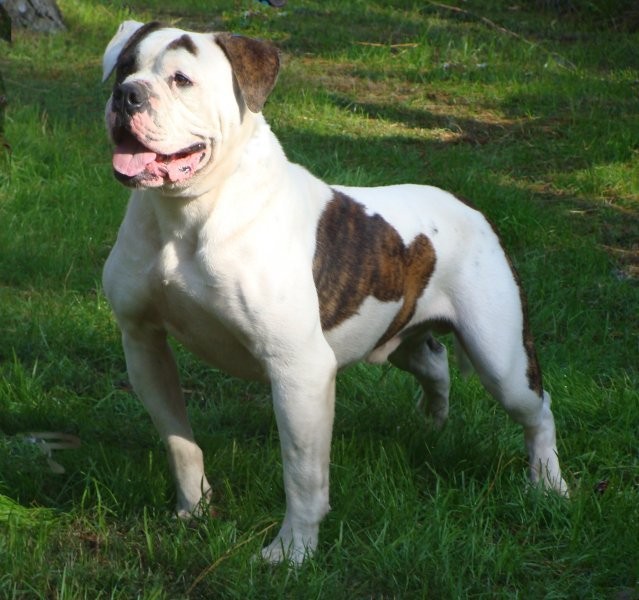
The Johnson type American Bulldog represents the traditional lineage of the breed, developed through the careful breeding program of John D. Johnson in the post-World War II era. This variant embodies the classic bulldog characteristics with its robust build, pronounced muscular structure, and distinctive facial features. Distinguished by a larger head, shorter muzzle, and stockier frame compared to other types, the Johnson line aims to preserve the historical attributes of the original working bulldogs. These dogs exemplify power and athleticism while maintaining the breed's fundamental working capabilities and traditional appearance.
Johnson Type American Bulldog Characteristics
Physical Appearance
The Johnson type, also known as the "classic" type American Bulldog, features a distinctly large and broad head with a box-shaped to rounded skull. They have a more definitive stop and more facial wrinkles compared to other types. The muzzle length is typically 25-35% of the overall head length, with a pronounced undershot bite of approximately 1/4 inch being preferred. These bulldogs are bulkier in body, heavier in bone structure, and possess greater muscle mass compared to the Scott type.
Historical Development
The Johnson type emerged through the breeding program of John D. Johnson in the post-WWII era. Johnson gathered the finest examples of the breed he could find and focused on preserving traditional bulldog characteristics. His breeding philosophy emphasized maintaining the powerful working dog traits while retaining the historical attributes reminiscent of the original English Bulldog. This careful selection process resulted in dogs that excelled at traditional bulldog work while displaying impressive strength and athletic capabilities.
Johnson Type American Bulldog Physical Characteristics
Size and Build
The Johnson type American Bulldog exemplifies substantial physical presence, with males typically reaching heights of 23-27 inches and females 20-25 inches at maturity. These dogs feature an imposing chest that is deep and moderately wide, providing ample space for heart and lungs. Their build is characterized by heavy bone structure and dense muscling throughout the body, particularly evident in their thick neck, broad shoulders, and powerful hindquarters.
Distinctive Features
While the previous reports covered general head characteristics, this section focuses on other unique physical traits. The Johnson type displays prominent cheek muscles and a well-defined chin that neither overlaps the upper lip nor is covered by it. Their ears are characteristically small to medium in size and set high on the skull. The tail is notably thick at the base, tapering to a point, and typically reaches the hock joint. Their coat is short and close-lying, ranging from soft to stiff in texture, and comes in various color patterns except for solid black, blue, merle, or tricolor combinations. A full black mask is also considered unacceptable according to breed standards.
Johnson Type American Bulldog Breed Standard and Conformation
Conformation Requirements
While previous reports covered general physical traits, this section focuses specifically on breed standard conformity. The Johnson type must demonstrate proper balance between height and weight, with a body that is just slightly longer than tall. The topline should incline very slightly downward from well-developed withers to a broad, muscular back. The loin must be short, broad, and slightly arched, blending into a slightly sloping croup. Serious faults include swayback and steeply sloping toplines that deviate from the standard.
Movement and Gait Standards
The Johnson type American Bulldog must exhibit specific movement patterns to meet breed standards. When trotting, the gait should be effortless, smooth, and powerful, demonstrating good reach in front and drive behind. The topline remains level during movement, showing only slight flexing to indicate suppleness. When viewed from any position, legs should neither turn in nor out, and feet should not cross or interfere with each other. As speed increases, feet tend to converge toward the center line of balance. Any poor movement that reduces the dog's ability to perform traditional working tasks is considered a fault according to breed standards.
Johnson Type American Bulldog Training Requirements
Mental Stimulation Needs
While previous reports covered physical traits and standards, this section focuses on the Johnson type's cognitive requirements. These bulldogs need structured mental exercises and consistent routines to prevent anxiety and undesirable behaviors. Due to their protective nature and strong guarding instincts, Johnson types require focused training on appropriate responses to strangers and unfamiliar situations. Early socialization is especially critical for this type to develop proper temperament control given their more intimidating physical presence.
Training Approach Specifics
The Johnson type requires specialized training considerations due to their sensitive nature despite their imposing appearance. These dogs respond poorly to harsh corrections and thrive instead on positive reinforcement with clear rules and structure. Training sessions should be designed to engage both their physical capabilities and mental faculties, incorporating tasks that utilize their natural strength and protective instincts constructively. Their tendency toward independence means handlers must establish firm but gentle leadership while avoiding overly strict methods that could hamper their willingness to learn and cooperate.
Conclusion
The Johnson type American Bulldog represents a distinct variation of the breed, characterized by its imposing physical presence, broad head, and muscular build. These dogs typically feature a box-shaped skull, pronounced stop, facial wrinkles, and an undershot bite, along with substantial bone structure and muscle mass that sets them apart from other types. Males stand 23-27 inches tall, with females slightly smaller at 20-25 inches. The breed emerged through John D. Johnson's careful post-WWII breeding program aimed at preserving traditional bulldog traits while maintaining working capabilities.
These physical characteristics have important implications for training and care requirements. Johnson type American Bulldogs need structured mental stimulation and consistent positive reinforcement training approaches that respect their sensitive nature despite their intimidating appearance. Early socialization is crucial for developing proper temperament control. Their unique combination of power and sensitivity means owners must establish clear leadership while avoiding harsh methods that could compromise the dog's willingness to learn and cooperate. Understanding these distinct traits and requirements is essential for successful ownership and preservation of this classic bulldog type.